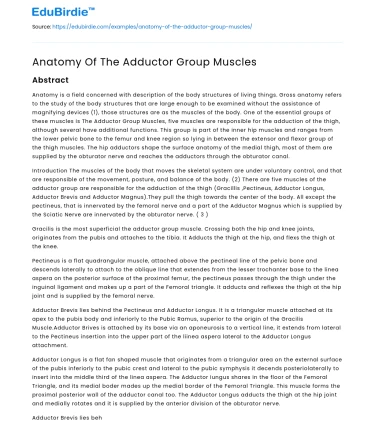Abstract
Anatomy is a field concerned with description of the body structures of living things. Gross anatomy refers to the study of the body structures that are large enough to be examined without the assistance of magnifying devices (1), those structures are as the muscles of the body. One of the essential groups of these muscles is The Adductor Group Muscles, five muscles are responsible for the adduction of the thigh, although several have additional functions. This group is part of the inner hip muscles and ranges from the lower pelvic bone to the femur and knee region so lying in between the extensor and flexor group of the thigh muscles. The hip adductors shape the surface anatomy of the medial thigh, most of them are supplied by the obturator nerve and reaches the adductors through the obturator canal.
Introduction The muscles of the body that moves the skeletal system are under voluntary control, and that are responsible of the movement, posture, and balance of the body. (2) There are five muscles of the adductor group are responsible for the adduction of the thigh (Gracillis ,Pectineus, Adductor Longus, Adductor Brevis and Adductor Magnus).They pull the thigh towards the center of the body. All except the pectineus, that is innervated by the femoral nerve and a part of the Adductor Magnus which is supplied by the Sciatic Nerve are innervated by the obturator nerve. ( 3 )
Gracilis is the most superficial the adductor group muscle. Crossing both the hip and knee joints, originates from the pubis and attaches to the tibia. It Adducts the thigh at the hip, and flexs the thigh at the knee.
Pectineus is a flat quadrangular muscle, attached above the pectineal line of the pelvic bone and descends laterally to attach to the oblique line that extendes from the lesser trochanter base to the linea aspera on the posterior surface of the proximal femur, the pectineus passes through the thigh under the inguinal ligament and makes up a part of the Femoral triangle. It adducts and reflexes the thigh at the hip joint and is supplied by the femoral nerve.
Adductor Brevis lies behind the Pectineus and Adductor Longus. It is a triangular muscle attached at its apex to the pubis body and inferiorly to the Pubic Ramus, superior to the origin of the Gracilis Muscle.Adductor Brives is attached by its base via an aponeurosis to a vertical line, it extends from lateral to the Pectineus insertion into the upper part of the liinea aspera lateral to the Adductor Longus attachment.
Adductor Longus is a flat fan shaped muscle that originates from a triangular area on the external surface of the pubis inferiorly to the pubic crest and lateral to the pubic symphysis it decends posteriolaterally to insert into the middle third of the linea aspera. The Adductor Iungus shares in the floor of the Femoral Triangle, and its medial boder mades up the medial border of the Femoral Triangle. This muscle forms the proximal posterior wall of the adductor canal too. The Adductor Longus adducts the thigh at the hip joint and medially rotates and it is supplied by the anterior division of the obturator nerve.
Adductor Brevis lies behind the Pectineus and Adductor Longus. It is a triangular muscle attached at its apex to the pubis body and inferiorly to the Pubic Ramus, superior to the origin of the Gracilis Muscle. Adductor Brives is attached by its base via an aponeurosis to a vertical line, it extends from lateral to the Pectineus insertion into the upper part of the liinea aspera lateral to the Adductor Longus attachment. It adducts the thigh and medially rotates it at the hip joint and supplied by the obturator nerve.
Adductor Magnus is the largest and deepest muscle in the medial compartment of the thigh. The muscle makes up the distal posterior Adductor Canal wall. Like the Addutor Longus and Adductor Brevis muscles. The Adductor Magnus is a triangular muscle. Its apex attached to the pelvis and its base expanted to attach to the femur on the pelvis. The part of the muscle that originates from the Ischiopubic Ramus expands laterally and inferiorly to attach to the femur. This lateral part is known as the “Adductor Part” of the Adductor Magnus. The medial part of this muscle is called the “The Hamstring Part”, originates from the ischial tuberosity and extends vertically along the thigh to insert into the adductor tubercle on the medial condyle of the head of the distal femur via a rounded tendon. It inserts into the medial suoracondylar ridge. The Adductor Magnus adducts the thigh at the hip joint and medially rotates it. The adductor part of the muscle is supplied by the obturstor nerve and the hamstring part is supplied by the tibial division of the sciatic nerve.
References
- Contributor:The Editors of Encyclopaedia Britannica Article Title:Anatomy Website Name:Encyclopædia Britannica Publisher:Encyclopædia Britannica, inc. Date Published:September 26, 2018
- Contributors:Robin Huw Crompton, Bernard Wood and Others Article Title: Human muscle system Website Name: Encyclopædia Britannica, inc. Date Published: April 26,2018
- Gray's Anatomy for Students Textbook by Adam W. M. Mitchell and Wayne Vogl Pages (581, 588, 589)
- Anatomy of the lower limb by staff members of anatomy and embryology department, Faculty of Medicine KFS University.






 Stuck on your essay?
Stuck on your essay?

